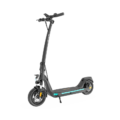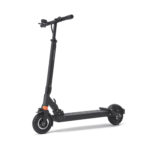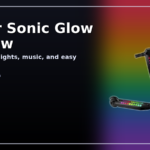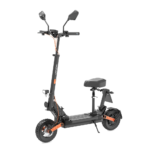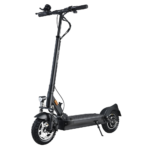- Home
- Scooters
- Electric Scooters
- JOYOR E6-S
JOYOR E6-S


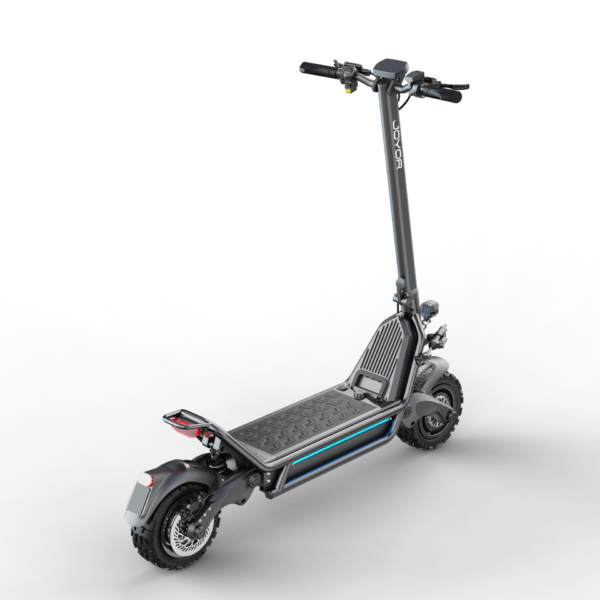
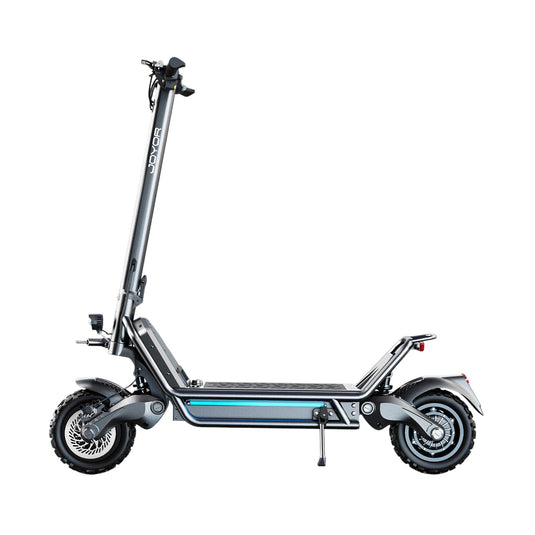
- Battery Range: 43–62 mi (70–100 km)
- Top Speed: 43–50 mph (70–80 km/h)
- Motor Power: 2 × 1600 W dual hub motors
- Weight Capacity: 330 lb (150 kg)
- Charging Time: ~11–12 h
- Scooter Weight: 108.0 lb (49.0 kg)
PROS
- Dual 1600 W motors for strong torque
- Large 60 V 31.5 Ah battery for long range
- Front & rear hydraulic disc brakes
- 11″ pneumatic tires + front/rear suspension
- Reinforced fold; bright cockpit display
CONS
- Heavy to carry upstairs
- Range drops with cold, hills, and high speed
- Pneumatic tires require pressure checks
- Top speed may be legally limited on public roads

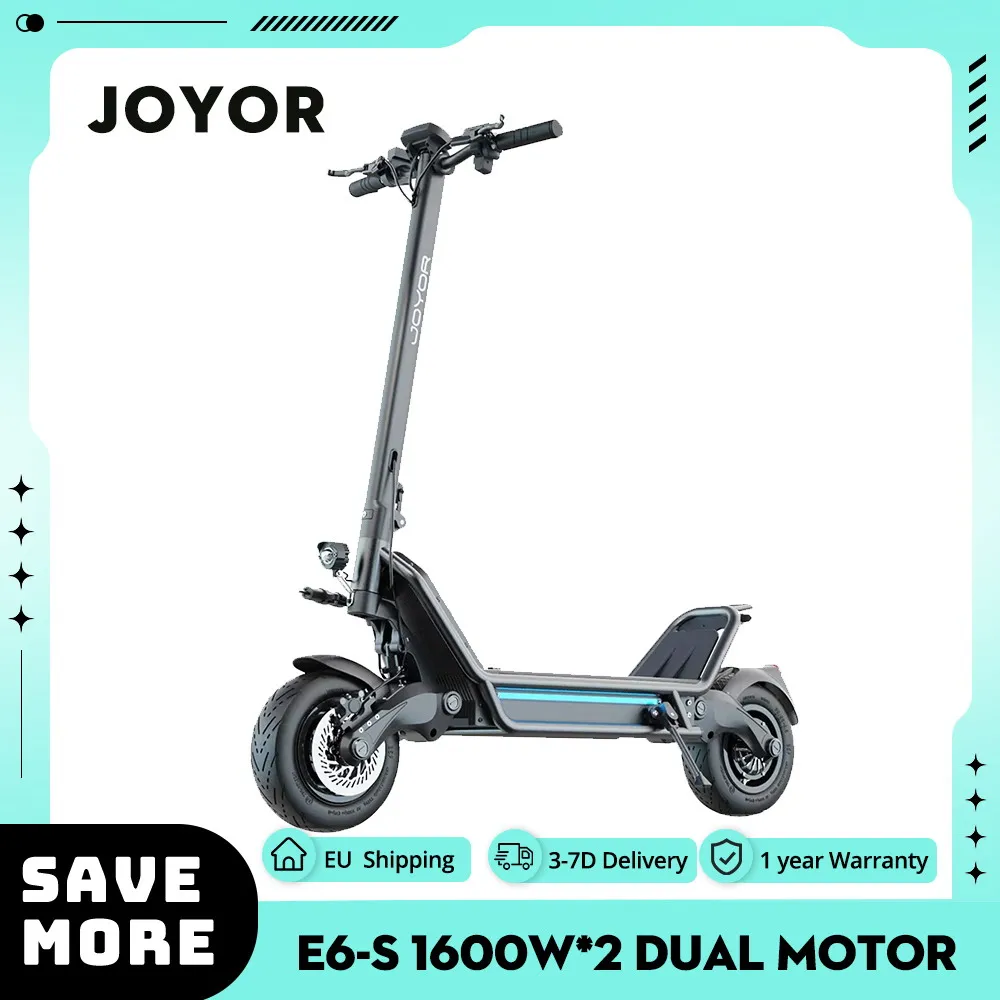
Table of contents
- What Is the JOYOR E6-S?
- How the JOYOR E6-S Works
- Key Specifications
- Design & Build Quality
- Performance Fundamentals
- Battery, Range & Efficiency
- Ride Quality & Comfort
- Braking & Safety Features
- Portability & Daily Usability
- Maintenance & Care
- Weather & Seasonal Considerations
- JOYOR E6-S vs Alternatives
- Who the JOYOR E6-S Is (and Isn’t) For
- FAQs
- Glossary
If you want a dual-motor scooter that feels planted, pulls hard, and soaks up poor pavement, the JOYOR E6-S sits near the top of that heap. It pairs burly 11-inch pneumatic tires with front and rear suspension and hydraulic disc brakes. As a result, it rides like a serious machine rather than a toy. This overview breaks down what it is, how it works, and how to get the most out of it—while also pointing you to our JOYOR S10-S-Z electric scooter review if you’re cross-shopping in the same family.
What Is the JOYOR E6-S?
The JOYOR E6-S is a high-performance, dual-motor electric scooter built around an aluminum alloy chassis and a large 60 V battery. It’s aimed at experienced riders who prioritize strong acceleration, long range, and stable handling. Because it uses 11-inch air-filled tires plus dual suspension, it feels composed on rough asphalt and light dirt. Meanwhile, hydraulic disc brakes bring it down from speed with predictable control. Although the scooter can be limited for compliance at 25 km/h, its underlying hardware is capable of much more, so owners should treat it with the same care they would a small motorbike.
The platform is heavy at roughly 49 kg, so it’s best for riders who don’t need to haul it up multiple flights of stairs. However, the long deck, wide cockpit, and confident stance make longer rides less fatiguing. In short, this is a long-range, high-stability scooter for riders who value control and power in equal measure.
How the JOYOR E6-S Works
At its core, the E6-S is a simple system: a battery feeds two hub motors through an electronic controller, and your hands manage everything from a handlebar console.
Motor and Controller. Two 1600 W hub motors live in the front and rear wheels. Think of each hub motor as a sealed can of magnets and copper windings. When the controller sends pulsed current, the stator and rotor create a rotating magnetic field that turns the wheel. Because both wheels are powered, the scooter launches with authority and keeps pulling on hills that slow single-motor models. The controller also manages riding modes and speed limits, acting like a traffic cop for the power system.
Battery. A 60 V, 31.5 Ah lithium pack stores the energy. Picture it as a water tank: voltage is the pressure, and amp-hours are the tank size. Higher pressure helps power delivery at speed, while a larger tank makes the ride last longer. The pack is mounted low in the deck, which lowers the center of gravity and improves stability.
Throttle. A thumb or trigger throttle (depending on batch) sends the controller a simple request: how much power do you want right now? As you press, the controller delivers more current to the motors. Because two wheels respond, the sensation is smoother and less front-heavy than on single-motor scooters.
Brakes. Front and rear hydraulic disc brakes convert speed into heat via calipers squeezing rotors. The “hydraulic” part matters because fluid transmits your lever force more consistently than cables, which stretch. Therefore, you get firm bite with a light lever pull and better modulation on steep descents.
Lights and Console. A color LCD display shows speed, battery bars, trip data, and selected mode. Lighting equipment varies by market, yet you should expect a forward headlight and rear light integrated with braking. Always verify local equipment rules before night riding.
Key Specifications
The table below consolidates the official, core data riders use most when comparing models.
| Block | Details |
|---|---|
| General | Frame: aluminum alloy; Display: multifunction color LCD; Speed levels: 3; Intended use: experienced riders and long-range excursions |
| Performance & Power | Dual hub motors: 2×1600 W (nominal); Max speed: 70 km/h (compliance-limited mode: 25 km/h); Hill climb: up to 20° |
| Battery, Charging & Electrical | Battery: 60 V 31.5 Ah lithium; Claimed range: 70–85 km; Charge time: 11–12 h; Cruise control: Advanced Cruise Control |
| Build & Dimensions | Tires: 11-inch pneumatic front and rear; Suspension: front and rear; Weight: 49 kg; Max load: 150 kg; Unfolded: 1420×620×1330 mm; Folded: 1420×620×530 mm |
| Safety & Control | Brakes: front and rear hydraulic disc; Lighting: front/rear lights (market-dependent); Three speed levels for graduated control |
| Features & Extras | Dual suspension, large deck, wide cockpit, color LCD, cruise control; off-road-friendly tire profile on many units |
| Warranty & Compliance | Limited warranty on electrical parts generally 24 months; battery 12 months or 2000 km (whichever comes first); purchases in Spain may carry 36 months warranty per local policy; not approved for use in public spaces in Spain or Germany; observe local regulations in all regions |
Design & Build Quality
The E6-S looks purposeful. The deck is long and wide, so you can stagger your feet comfortably or square up when crawling over curbs and rough patches. The frame uses aluminum alloy, which balances strength and corrosion resistance while keeping weight in check given the scooter’s size. Welds are robust, and the swingarms for the suspension feel solid when you lift the rear.
The stem locks down with a heavy-duty mechanism designed to manage chassis loads at higher speeds. When properly tightened, stem flex is minimal in steady cruising. Nevertheless, it’s good practice to check the collar clamp before rides; even small looseness can translate into a vague steering feel. The cockpit is wide enough for shoulder-width grips, levers, and a display without feeling cramped. Additionally, cable routing is tidy for this class: not race-bike sleek, but not messy either.
Fit-and-finish reflects the scooter’s mission. The hardware feels substantial, the deck grip is coarse enough for wet-shoe traction, and the fenders cover an ample portion of the tires. Furthermore, the folding hinge folds the stem over the deck without high effort, which helps during transport. Because the folded package is still long, it fits in many car trunks diagonally rather than straight in.
Performance Fundamentals
Acceleration. Dual 1600 W motors deliver the kind of launch that can surprise unprepared riders. Therefore, start in the lowest speed level until you calibrate your throttle hand. From a standstill, the scooter responds immediately; once the tires hook up, it surges forward with a linear feel rather than a sudden spike.
Cruising Stability. The wheelbase and 11-inch air tires contribute to a planted ride. As speed increases, the chassis tracks straight with little shimmy if tires are fresh and properly inflated. Moreover, the dual suspension filters out chatter that would upset smaller scooters. On long, straight stretches, you can rest into the deck and let the suspension and tires keep things calm.
Hill-Climb Behavior. On 7–10% grades, the E6-S keeps rolling in mid to high speed levels. Because both wheels drive, it doesn’t bog as quickly as single-motor scooters when you crest a hill. Even so, very steep ramps still demand a shorter throttle pull and a proactive stance over the deck. While the spec lists up to 20° climbs under favorable conditions, real hills with rough surfaces will require momentum and a moderate pace.
Steering and Feel. Turn-in is predictable. The wide bar gives you leverage, and the front suspension soaks up brake-induced weight transfer. Through patches of broken pavement, you’ll notice less hand shock than on scooters with solid tires or shorter stems. As a result, long rides feel less fatiguing.
Battery, Range & Efficiency
Rated range sits between 70 and 85 km on a full charge. In practice, your result varies. Rider mass, average speed, elevation, temperature, and surface type matter a lot. For a 75–85 kg rider on mixed city streets, you can expect a healthy portion of the rated figure if you cruise in lower speed levels and accelerate smoothly. However, frequent hard launches, headwinds, and cold temperatures will reduce distance.
Temperature Effects. Lithium batteries prefer mild conditions. Below ~50 °F (10 °C), internal resistance rises and practical range falls. Above ~95 °F (35 °C), high pack temperatures can also limit output. Therefore, if you ride year-round, plan for buffer miles in winter and avoid storing the battery in hot cars during summer.
Charging Best Practices. Let the battery rest at room temperature before charging. Avoid routinely running the pack to zero; instead, stop around 20–25% remaining when possible. For storage longer than a week, park the scooter around 50–70% charge and top it up every few weeks. Additionally, keep the charge port cap sealed while riding to avoid contamination.
Efficiency Habits. Small changes help: keep tires at the recommended pressure, maintain a steady cruise in a lower speed level on flat ground, and ease off the throttle sooner when approaching stops rather than sprinting and braking hard. Over a month, these habits add noticeable distance between charges.
Ride Quality & Comfort
The E6-S leans into comfort without feeling vague. The 11-inch pneumatic tires create a large contact patch and more sidewall compliance than 8.5–10-inch setups. Consequently, they mute cracks, expansion joints, and light gravel. The dual suspension then filters bigger hits and keeps the chassis level through dips. On polished concrete and smooth asphalt, the scooter glides; on beat-up streets, it stays predictable enough to maintain pace.
Ergonomics. The deck height lets most riders bend their knees naturally without squatting. With a wide bar and adjustable lever reach, you can set a neutral wrist angle and keep a light touch on the throttle. Because the scooter is heavy, a relaxed but active stance makes slow-speed maneuvering easier.
Stem Flex and Resonance. Every long stem has some elasticity. Here, flex is controlled under forward braking and mid-speed bumps. If you ever notice a waggle, check that the clamp and hinge bolts meet torque, and inspect tire balance. Balanced tires and correct pressure reduce headshake dramatically.
Braking & Safety Features
Hydraulic discs front and rear give the E6-S authoritative stopping power. On clean pavement, one finger on each lever often suffices for routine stops. If you squeeze to the halfway point, the bite firm ups, and the calipers hold speed in check without abrupt lockup. In the wet, reduce lever pressure and extend your braking zones.
Lighting and Visibility. The scooter includes front and rear lighting as standard equipment, though output can vary by region. Add reflective elements to your helmet or jacket and consider a supplemental bar-mounted light if you ride in unlit areas. Additionally, aim the headlight slightly down to avoid dazzling oncoming traffic.
Weather Resistance. The manufacturer’s warranty excludes use in wet conditions. That guidance should set your baseline: avoid heavy rain, standing water, and high-pressure hose downs. Wipe the scooter dry after light splashes and store it indoors so connectors stay corrosion-free.
Portability & Daily Usability
At roughly 49 kg, the E6-S is not a light carry. You can lift the rear to pivot, and you can roll it curb-to-curb without struggle, but full stair carries are a two-person job for most riders. The folded dimensions—about 1420×620×530 mm—fit many hatchbacks and wagons; angle the deck and slide in motor-first. Use a strap to keep the stem from swinging when folded.
Folding Mechanism. The hinge feels stout and closes with a decisive action. Always ensure the latch engages fully; partial latches create play you can feel under braking. Before riding, extend the stem, lock the latch, and tug the bar to confirm a solid connection.
Daily Habits. Because this scooter draws attention, develop consistent locking and storage routines. At work, park within sight or in a secured room if possible. At home, keep it on a mat to catch water and grit, and position a small charger shelf near a grounded outlet to avoid cable strain.
Maintenance & Care
A simple, consistent routine keeps performance high and surprises low.
Before Every Ride (60–90 seconds):
- Check tire pressure with a gauge; top up if needed.
- Squeeze each brake lever; confirm firm feel and no rubbing.
- Inspect the folding latch and stem clamp for tightness.
- Glance at fasteners on the calipers, swingarms, and axles.
Weekly:
- Wipe down the frame and deck; look for cracks or loose hardware.
- Spin wheels by hand; listen for grinding that might indicate contamination.
- Verify throttle and display functions; ensure mode changes work as expected.
Monthly or Every 200–300 km:
- True and clean the brake rotors if you hear pulsing; re-bed pads if glazed.
- Inspect suspension bushings and pivot bolts; snug to manufacturer guidance.
- Check deck screws and fender mounts; vibration can loosen them over time.
Battery Care:
- Keep charge levels between 20% and 90% for routine use.
- For storage, aim for ~50–70% and a cool, dry room.
- Avoid charging immediately after a hard ride; let the pack cool to room temp.
Firmware/Settings:
- If your unit supports controller parameters, avoid aggressive, untested settings. Small changes to acceleration ramps can be fine, but extreme values may stress components or reduce reliability.
Weather & Seasonal Considerations
Rain. Because wet use is excluded under warranty, treat rain as a cue to stop or slow dramatically. Painted lines and metal plates become slick. As a precaution, reduce tire pressure slightly within the safe range for better grip, and lengthen braking distances.
Cold. Expect range loss and slightly lazier throttle response as temperatures drop. Dress warmly so you can keep a relaxed grip; cold hands lead to choppy inputs. Additionally, charge indoors and head out with a warm pack for better early-ride performance.
Heat. High heat can raise battery and controller temperatures. Park in shade, avoid leaving the scooter in a hot car, and consider shorter stints with cool-down pauses during heat waves.
JOYOR E6-S vs Alternatives
Versus Commuter Scooters. Compared with 500–800 W single-motor commuters, the E6-S accelerates harder, climbs better, and remains more stable at speed. However, commuters are lighter and easier to carry into apartments and transit. If you face many stairs or prioritize compactness above all else, a commuter may suit you more.
Versus Mid-Performance Dual-Motors. Against smaller dual-motor models with 10-inch tires, the E6-S rides smoother and feels calmer on rough surfaces. It also tends to offer longer range thanks to its big battery. On the flip side, mid-performance rivals are usually easier to lift and store.
Versus Off-Road-Oriented Machines. In loose gravel or dirt, the E6-S behaves predictably as long as you modulate the throttle and keep weight light over the front. Dedicated off-road builds may have more aggressive tires and taller suspension travel. Yet, for mixed urban-trail use, this scooter strikes a useful balance.
In short, the E6-S excels when the priority list reads: stability, power, and range. It’s less ideal when you need frequent lifts or ultra-compact storage.
Who the JOYOR E6-S Is (and Isn’t) For
A Good Fit For:
- Riders who want confident high-speed stability and strong hill performance.
- Suburban commuters with ground-level storage or elevator access.
- Weekend explorers who mix city streets with packed paths and light off-road.
- Heavier riders who benefit from a high load rating and wide deck.
Not the Best Fit For:
- Students in walk-up apartments who must carry it daily.
- First-time riders who haven’t developed throttle discipline.
- Strict urban environments where public-space approval is limited; always check local rules.
FAQs
1) Is there a simple JOYOR E6-S overview I can share with friends?
Yes. It’s a dual-motor, aluminum-frame scooter with 11-inch pneumatic tires, front and rear suspension, hydraulic disc brakes, and a 60 V, 31.5 Ah battery designed for long, stable rides.
2) How fast can it go, and what about limited modes?
Hardware capability reaches around 70 km/h, but many markets use a 25 km/h limited mode for compliance. Always follow local rules and ride within your skill level.
3) What range should I expect in real conditions?
The rated window is 70–85 km. Real-world range depends on rider mass, speed, temperature, and terrain. Smooth throttle use and moderate speeds extend distance.
4) How does the braking feel?
The hydraulic system offers firm bite after a short lever pull and easy modulation. On clean pavement, one-finger control often suffices; in wet conditions, brake earlier and more gently.
5) Can I ride it in the rain?
Riding in wet conditions is not recommended and is excluded under warranty. If you get caught in light rain, slow down, avoid puddles, and dry the scooter afterward.
6) What about maintenance intervals?
Check tire pressure and the folding latch before every ride, wipe the scooter weekly, and inspect brakes and fasteners monthly. Keep the battery between 20% and 90% for routine use.
7) Does it have cruise control?
Yes, the E6-S includes advanced cruise control so you can maintain a steady pace on long, straight stretches without holding the throttle.
Glossary
- Ah (Amp-hour): Battery capacity measure; higher Ah means more stored energy.
- Wh (Watt-hour): Total energy (voltage × amp-hours); predicts range better than Ah alone.
- Controller: The electronic brain that regulates current to the motors and manages modes.
- Dual Motor: Two hub motors—one in each wheel—for better acceleration and hill performance.
- Hydraulic Brake: A braking system in which fluid transmits lever force to calipers for strong, consistent stopping.
- Modulation: Your ability to meter braking force smoothly rather than on/off.
- Regen (Regenerative Braking): System that recovers energy during deceleration; hydraulic discs provide primary braking on this model.
- Stem Flex: The slight elastic movement felt at the handlebar; minimized by proper clamp tension.
- IP Rating: Ingress protection code indicating dust/water resistance; wet use is not covered under warranty for this model.
- Pneumatic Tire: Air-filled tire that improves comfort and grip versus solid designs.
- Torque: Rotational force from the motors; more torque helps starts and hill climbs.
- Speed Level: Pre-set performance modes that cap acceleration and top speed for control.
- Battery Management: Practices that prolong pack health, including partial charging and cool storage.
- Wheelbase: Distance between wheel centers; longer wheelbases are generally more stable.
- Deck: The standing platform; width and length affect comfort and stance options.
Specifications
General
| Model The Model specifies the exact version or name of the scooter. It helps identify its unique design, features, and specifications within the manufacturer’s product line. Knowing the model makes it easier to compare options, find compatible accessories, or look up support information. | E6-S |
| Brand The Brand identifies the manufacturer or company that designs and produces the scooter. A trusted brand is a sign of quality, reliability, and good customer support. Well-known brands often have higher standards for safety, performance, and after-sales service, giving you more confidence in your purchase. | JOYOR |
| Release Date The Release Date indicates when the scooter model was officially launched on the market. This helps you know how current the design, technology, and features are. A newer release date often means updated components, improved performance, and the latest safety or smart features. | 17 November 2025 |
| Recommended Age Recommended Age indicates the minimum age range that the scooter is designed for, based on safety, size, and ease of use. Following the recommended age helps ensure that riders can handle the scooter’s speed, weight, and controls comfortably and safely. Always check local laws and use protective gear, especially for younger riders. | Recommended 14+ |
Performance & Power
| Motor Power (Wattage) What it means: The motor power, measured in watts (W), shows how strong the scooter’s electric motor is. Why it matters: Higher wattage usually means better acceleration, more torque, and improved performance on hills or rough terrain. For example, a 250W motor is good for flat city roads and light riders, while a 500W or 1000W motor provides more power for faster speeds or climbing steep inclines. | 2 × 1600 W dual hub motors |
| Top Speed The Top Speed indicates the maximum speed that the scooter can reach under optimal conditions. It’s usually measured on level ground with a fully charged battery and an average rider weight. A higher top speed allows you to travel longer distances faster, but always ensure you ride within legal speed limits and your personal comfort zone for safety. | Up to 70–80 km/h (25 km/h limited in some regions) |
| Battery Capacity Battery Capacity refers to the total amount of energy the scooter’s battery can store, usually measured in ampere-hours (Ah) or watt-hours (Wh). A higher battery capacity means you can ride longer distances on a single charge, reducing the need for frequent recharging. Keep in mind that actual range can vary depending on rider weight, terrain, speed, and weather conditions. | 60 V 31.5 Ah (≈1890 Wh) |
| Estimated Range per Charge The Estimated Range per Charge indicates the average distance the scooter can travel on a single full battery charge. This range is calculated under optimal conditions, such as flat terrain, moderate speed, and average rider weight. Real-world range may vary depending on riding style, terrain, weather, and load. A longer range means fewer recharges and greater freedom for longer trips. | 70–100 km per charge |
| Hill Climb Ability Hill Climb Ability describes the maximum incline or slope that the scooter can handle while maintaining stable performance. It’s typically expressed as a percentage or in degrees. A higher hill climb rating means the scooter can tackle steeper hills without losing too much speed or power. Actual climbing performance may vary based on rider weight, battery charge, and terrain conditions. | Up to 30° grades |
| Drive System The Drive System refers to how power from the motor is delivered to the wheels. Electric scooters typically use either a hub motor (directly integrated into the wheel) or a chain/belt drive system. A high-quality drive system ensures smooth acceleration, efficient power transfer, and low maintenance. The choice of drive system affects performance, noise level, and overall ride experience. | Dual hub motors (2WD) |
Charging & Electrical
| Charging Time Charging Time indicates how long it takes to fully recharge the scooter’s battery from empty to 100% using the standard charger provided. Faster charging means less downtime and more time on the road. Actual charging time may vary slightly depending on battery capacity, charger output, and environmental conditions. | Approx. 11–12 hours |
| Battery Type Battery Type refers to the specific technology used in the scooter’s battery, which affects performance, lifespan, weight, and charging time. Most modern electric scooters use high-quality lithium-ion (Li-ion) batteries because they offer a good balance of energy density, durability, and low maintenance. A reliable battery type ensures consistent power delivery and longer riding ranges. | Li-ion pack with Smart BMS |
| Removable Battery A Removable Battery means the battery pack can be easily detached from the scooter for convenient charging and replacement. This feature allows you to charge the battery separately, swap it with a spare for extended range, or securely store it indoors in extreme weather. Removable batteries add flexibility and make it easier to keep your scooter powered up wherever you are. | No |
| Regenerative Braking Regenerative Braking is an energy-saving feature that converts some of the energy normally lost during braking back into battery power. When you slow down or brake, the motor works in reverse to generate electricity, which helps extend the scooter’s range and improves overall efficiency. This system also reduces wear on traditional brake components, leading to lower maintenance over time. | Front & rear hydraulic discs + electronic assist |
| Lighting Lighting refers to the built-in front and rear lights that enhance visibility and safety when riding in low-light conditions or at night. Good lighting helps you see the road ahead and ensures that other road users can see you. Many scooters include LED headlights, taillights, and sometimes brake lights or side reflectors for added safety and compliance with local traffic regulations. | Headlight, tail/brake, turn signals (variant-dependent) + reflectors |
Build & Dimensions
| Scooter Weight Scooter Weight refers to the total weight of the scooter when fully assembled, including the battery. This affects how easy it is to carry, lift, and store the scooter when not in use. A lighter scooter is more portable and convenient for commuting, especially if you need to carry it upstairs or onto public transport. Keep in mind that a sturdy frame and quality components may add to the weight but also contribute to better durability and ride stability. | 108.0 lb (49.0 kg) |
| Maximum Rider Weight Maximum Rider Weight indicates the highest rider weight that the scooter is designed to safely support while maintaining optimal performance and stability. Staying within this limit helps ensure reliable acceleration, braking, and climbing ability, and it protects the frame, suspension, and motor from excessive strain. Exceeding the recommended limit may reduce performance and increase wear on components. | 330 lb (150 kg) |
| Deck Size Deck Size refers to the dimensions of the scooter’s standing platform. A wider and longer deck provides more foot space, allowing you to stand comfortably and adjust your stance while riding. A well-sized deck improves balance and stability, especially on longer rides or at higher speeds. Compact decks, on the other hand, help keep the scooter lightweight and portable. | Wide deck; off-road-ready stance |
| Handlebar Height Handlebar Height refers to the distance from the deck to the handlebars, which affects your riding posture and comfort. An appropriate handlebar height helps you maintain good balance, reduces strain on your back and arms, and makes steering more comfortable. Some scooters have adjustable handlebars to fit riders of different heights, while others have a fixed height for a streamlined design. | Adult fixed bar height |
| Folding Mechanism The Folding Mechanism describes how easily and securely the scooter can be folded for carrying and storage. A well-designed folding system lets you quickly collapse the scooter into a compact size, making it convenient to transport on public transit, store under a desk, or fit into a car trunk. Look for sturdy latches and safety locks to ensure the scooter stays firmly in place when folded or unfolded. | Reinforced folding latch |
| Dimensions Folded Dimensions indicate the size of the scooter when it’s fully folded. This measurement shows how much space the scooter will take up when stored or carried, making it easier to check if it will fit in your car trunk, under a desk, or in a closet. Compact folded dimensions are ideal for commuters who need to bring their scooter on public transport or store it in tight spaces. | 55.9 × 24.4 × 20.9 in (folded) / 1420 × 620 × 530 mm |
| Material Material refers to the primary construction materials used for the scooter’s frame and key components. High-quality materials like aircraft-grade aluminum, reinforced steel, or durable composites provide strength, stability, and a lighter overall weight. A sturdy material ensures the scooter can handle daily wear and tear while maintaining safety and performance. | Aluminum alloy frame |
Safety & Control
| Brake Type(s) Brake Type(s) describe the braking systems the scooter uses to help you slow down or stop safely. Common brake types include mechanical brakes (like drum or disc brakes), electronic brakes, and foot brakes. Many scooters combine multiple braking systems for added safety and shorter stopping distances. The type and quality of brakes affect your control, especially when riding at higher speeds or on slopes. | Hydraulic discs front & rear + e-assist |
| Suspension Suspension refers to the system that absorbs shocks and vibrations while riding, providing a smoother and more comfortable ride over uneven or rough surfaces. Scooters may have front suspension, rear suspension, or dual suspension for better shock absorption and stability. Good suspension helps reduce rider fatigue and improves control, especially when riding on bumpy roads or off-road paths. | Front & rear suspension |
| Tire Type Tire Type refers to the kind of tires the scooter uses, which directly affects ride comfort, traction, and maintenance. Common types include solid (airless) tires, pneumatic (air-filled) tires, or hybrid options. Pneumatic tires offer better shock absorption and a smoother ride on rough surfaces, while solid tires are puncture-proof and require less upkeep. The right tire type helps ensure safe handling and a comfortable ride in different conditions. | Pneumatic off-road street tires |
| Tire Size Tire Size indicates the diameter and width of the scooter’s tires, which affect ride comfort, stability, and how well the scooter handles different terrains. Larger tires generally offer better shock absorption and a smoother ride over bumps and rough surfaces, while smaller tires keep the scooter lighter and more portable. Choosing the right tire size helps ensure a balance between agility and comfort. | 11-inch |
| Kickstand The Kickstand is a built-in stand that allows you to park your scooter upright when it’s not in use. A sturdy kickstand keeps the scooter stable and prevents it from tipping over, protecting it from scratches and damage. It also makes storing and accessing your scooter more convenient, whether you’re at home, work, or on the go. | Side kickstand |
| Water Resistance Rating Water Resistance Rating indicates how well the scooter is protected against water and moisture, usually shown as an IP (Ingress Protection) rating. This rating helps you understand whether the scooter can handle light rain, splashes, or wet roads without damage. While most scooters are not fully waterproof, a good water resistance rating adds peace of mind when riding in changing weather conditions. Always avoid deep puddles or submerging the scooter to protect its electrical components. | IPX4 body |
Features & Extras
| Display/Console The Display (or Console) shows important real-time information about your ride, helping you monitor your scooter’s status at a glance. Typical displays show speed, battery level, distance traveled, and riding mode. Some models also include additional features like Bluetooth connectivity, app integration, or backlighting for better visibility at night. A clear and easy-to-read display enhances safety and convenience on every trip. | LCD dashboard |
| Ride Modes Ride Modes refer to the different speed and power settings you can choose to match your riding style or road conditions. Common modes include eco for maximum range and energy efficiency, standard for everyday balance, and sport or turbo for higher speed and stronger acceleration. Switching between ride modes allows you to customize performance, conserve battery, and ride safely in various environments. | Eco, Drive, Sport |
| Smart App Connectivity Smart App Connectivity lets you pair your scooter with a dedicated mobile app via Bluetooth. Using the app, you can monitor real-time ride stats like speed, battery level, and range, adjust settings such as ride modes or cruise control, lock the scooter for added security, and sometimes receive firmware updates. This feature adds convenience and allows you to personalize your riding experience right from your smartphone. | App-free basic operation |
| Anti-Theft System The Anti-Theft System helps protect your scooter from unauthorized use or theft. This feature can include built-in alarms, electronic motor locks, GPS tracking, or remote locking through a mobile app. A good anti-theft system provides peace of mind when parking your scooter in public spaces, adding an extra layer of security to safeguard your investment. | N/A |
| Cruise Control Cruise Control allows you to maintain a steady speed without continuously holding the throttle. This feature makes longer rides more comfortable by reducing hand fatigue and providing a smoother, more relaxed riding experience — especially on flat, open roads or bike lanes. For safety, cruise control can usually be easily activated or deactivated while riding. | Yes (cruise control) |
| Accessories Included Accessories Included lists the additional items that come with the scooter to enhance your riding experience and convenience. Common accessories may include a charger, kickstand, bell, lights, phone holder, or carrying strap. These extras add value by making your scooter safer, easier to use, and ready to ride straight out of the box. | Bell, reflectors, charger |
Warranty & Compliance
| Warranty Period The Warranty Period indicates how long the manufacturer guarantees the scooter against defects in materials and workmanship under normal use. A good warranty provides peace of mind, showing the brand’s confidence in its product quality. Always check what parts are covered, such as the frame, battery, and motor, and follow the maintenance guidelines to keep your warranty valid. | 12 months typical (region-dependent) |
| Certifications Certifications confirm that the scooter meets specific safety, quality, and environmental standards set by recognized organizations or regulatory bodies. Common certifications may include CE, RoHS, UL, or other local compliance marks, depending on your region. These certifications ensure that the scooter is manufactured to high standards and is safe and legal to use in your country. | Local micromobility compliance (note: off-road top speeds not for public roads) |
Price Comparison






